Chapter: Psychology: Sensation
The Stimulus: Sound
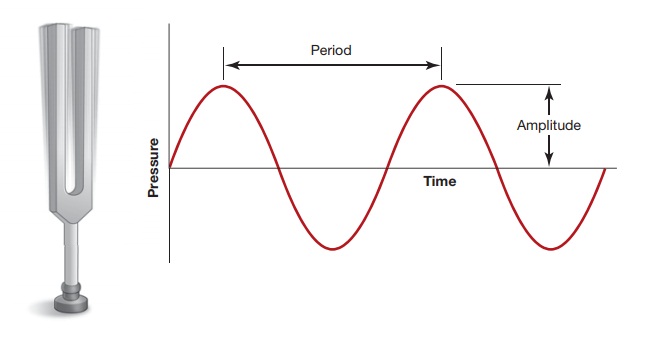
The Stimulus:
Sound
What is the stimulus for hearing?
Outside in the world, some physical object is moving—perhaps an animal
scurrying through the underbrush, or a set of vocal cords vibrating. This
movement agitates the air particles that surround the moving object, causing
these particles to jostle other particles, which in turn jostle still other
particles. The actual movement of these particles is slight (about one-billionth
of a centimeter) and short-lived; the particles return to their original
position in a few thousandths of a second. But the motion is enough to create a
momentary pressure that pushes outward from the moving object in a pattern
similar to the ripples that are set in motion by a stone thrown into a pond.
If the movement continues for
even a short time, it will create a series of pressure vari-ations in the air.
When these sound waves hit our ears,
they initiate a set of further changes that ultimately trigger the auditory
receptors. The receptors in turn trigger neu-ral responses, which eventually
reach the brain and lead to the experience of hearing.
Sound waves vary in many ways;
but, in the simplest case, they take the form shown in Figure 4.16. This is,
for example, the pattern that would result if a tuning fork were
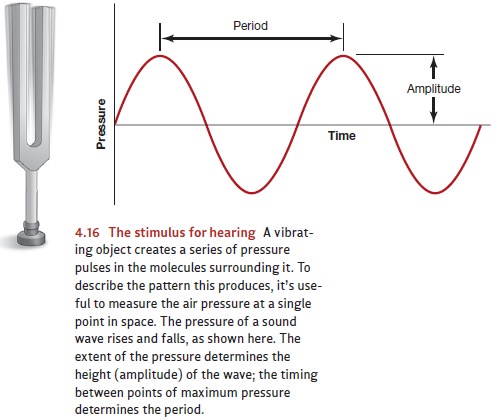
vibrating back and forth, pushing
on the air molecules next to it each time the vibration moves the fork in one
direction, and then pulling back on the same air molecules a moment later when
the vibration moves the fork in the other direction. That’s why the pressure
rises and falls as time goes by, in correspondence to the pushes and pulls the
tuning fork is creating. (A vibrating guitar string or a vibrating clarinet
reed have roughly the same effect, although these instruments produce a more
complex pattern than the one shown in the figure; other movements—like the
sound of a voice—would produce still more complex patterns.)
The pattern shown in Figure 4.16
is produced by a physical vibration and corre-sponds exactly to the plot of the
trigonometric sine function, so this wave can be accu-rately labeled a sine wave. To describe the wave more
precisely, we need to specify two things. First is the amplitude—the amount of pressure exerted by each air particle on
the next. As the figure shows, this pressure is constantly changing as the air
molecules vibrate toward each other, then away, then toward again. Thus, the
amplitude we actu-ally measure is the maximum
pressure achieved at the crest of the sound wave. Second, we need to specify
how widely spaced these pressure crests are. We could do this in terms of wavelength—a measurement of the distance
between one crest and the next— or in terms of period, a measure of how much time elapses between one crest and
the next. When measuring sounds, it’s usually more convenient to take the
inverse of the period; so, instead of measuring seconds per crest, we measure
crests per second, which is the frequency
of the wave. This means our measure is literally a count of how many times in
each second the wave reaches its maximum amplitude (Figure 4.17).
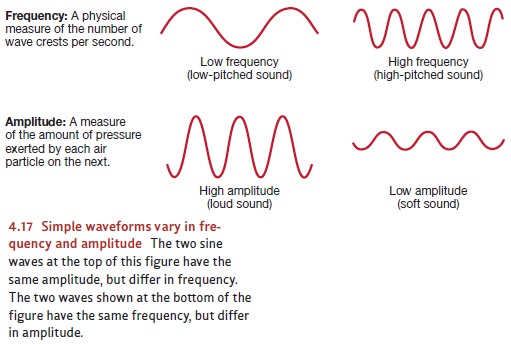
Amplitude and frequency are physical
dimensions of the sound wave itself, but they cor-respond reasonably well to
the psychological dimensions of loudness and pitch. Roughly speaking, a sound
will be heard as louder as its amplitude increases. It turns out that humans
can respond to an enormous range of amplitudes, so investigators find it useful
to measure these intensities with a logarithmic scale, which compresses the
range into a more convenient form. Specifically, sound intensities are measured
in decibels, and they’re always
assessed in relation to some standard. A standard of zero decibels is often
assumed to be the average detection threshold for an adult with normal hearing.
Loudness doubles each time the intensity of a sound increases by 10 decibels
(Stevens, 1955).
The frequency of a sound wave is
measured in cycles per second, or hertz
(named after the 19th-century physicist Heinrich Hertz). As frequency
increases, the subjective pitch of the sound goes up. Middle C on a piano
generally has a frequency of 261 hertz; the C an octave higher has a frequency
of 522 hertz. (In general, a doubling of frequency produces the experienced
pitch difference of one octave.) The frequencies associated with other musical
tones are shown in Table 4.3. Young adults can hear tones as low as 20 hertz
and as high as 20,000 hertz. As people get older, their sensitivity to sound
declines— especially at the higher frequencies. For this reason, sometimes
there’s little point for a
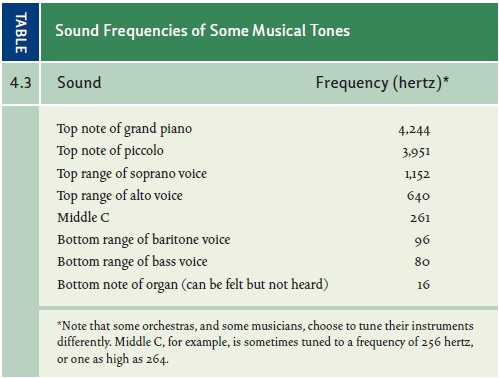
30- or 40-year-old to buy
expensive stereo equipment, since what makes the equipment expensive is often
its exquisite ability to reproduce high frequencies accurately! In many cases,
the middle-aged stereo buyer will be deaf to these frequencies and so probably
won’t be able to tell the difference between the expensive stereo and a cheaper
one.
So far, we’ve been talking only
about sine waves; but we rarely encounter sine waves in our everyday lives.
Instead, the sound waves we usually experience are far more complex. Figure
4.18A, for example, shows the moment-by-moment changes in air pressure produced
by a few seconds of music; Figure 4.18B shows the moment-by-moment pressure
changes produced by a bit of ordinary speech.
The mathematician Joseph Fourier
was able to show that these complex waves are actually just the sum of simpler
components—in particular, the sum of a series of sine waves. Essentially, we
can think of sine waves as the “ingredients” that combine to pro-duce more
complicated sounds. The “recipe” for creating the more complex sound must
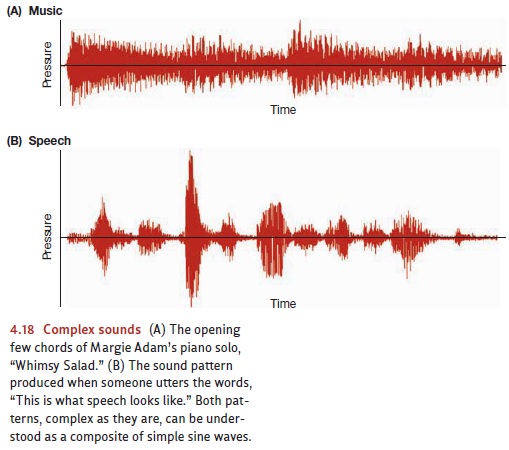
identify which ingredients are to
be used (i.e., which frequencies) and how much of each ingredient is needed
(i.e., how much amplitude for each of the frequencies is mixed into the whole).
But once that’s done, we can use the recipe to create any sound we choose from
sine-wave ingredients. Psychologists as well as physicists, audio engi-neers,
and many others routinely use Fourier analysis to describe in detail the sounds
we encounter in our day-to-day experience.
Related Topics